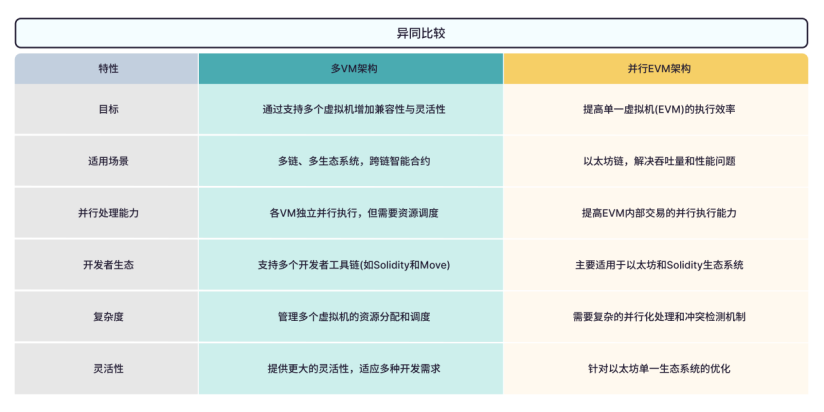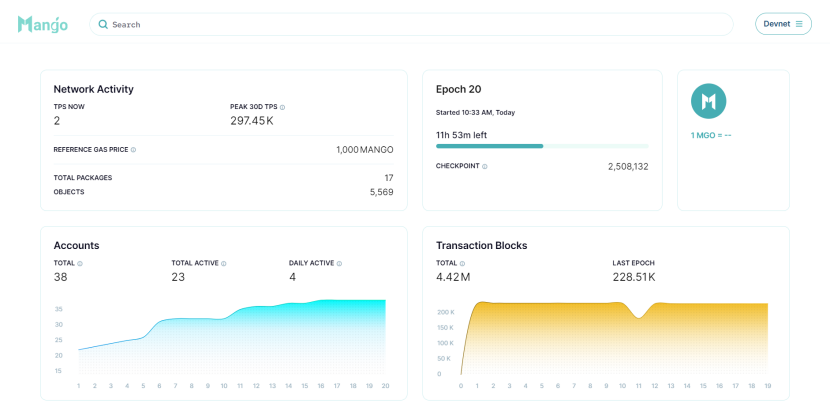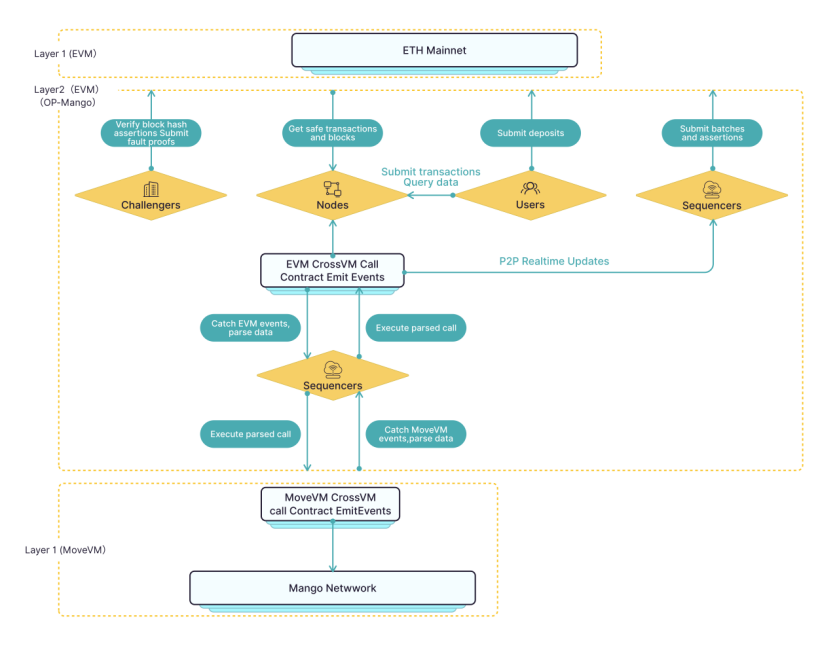The multi-VM architecture is the optimal solution to the current scalability and performance bottlenecks in blockchain, and it is becoming a new trend that promotes the deep integration of on-chain ecosystems. Mango Network, as an innovative full-chain infrastructure network, integrates the core advantages of OPStack technology and MoveVM, building an efficient blockchain network that supports cross-chain communication and multi-virtual machine interoperability. With better compatibility, scalability, developer friendliness, multi-chain interoperability, and enormous future potential, Mango Network has gained general market recognition.
Multi-VM Architecture: The Rising Star of the Blockchain Industry
Amid the excitement of Token2049 in Singapore, the blockchain industry is undergoing profound reflection and transformation. On the surface, the industry seems attracted by the prosperous scene of "thousands of chains launching simultaneously," but as the decentralized application ecosystem diversifies and becomes more complex, the need to break down barriers between blockchain ecosystems and promote cross-chain compatibility has become more urgent. Today, the priority of "compatibility" has surpassed "high performance," becoming the core challenge for the development of on-chain ecosystems.
For a long time, many institutions in the blockchain field have viewed parallel execution (parallel EVM) as a key technology to enhance network performance. Parallel EVM networks such as Artela, MegaETH, and Sei aim to promote the adoption of new applications by increasing throughput and transaction processing capabilities. Parallel EVM indeed performs excellently in high transaction volume environments, especially suitable for applications with stringent performance requirements like DeFi and DEX.
However, as the blockchain ecosystem diversifies, relying solely on performance improvements can no longer meet industry demands. The future development of on-chain ecosystems depends not only on enhancing transaction processing capabilities but also on improving the ecosystem's compatibility, especially in complex cross-chain and multi-chain environments, where this demand is becoming increasingly prominent.
As the importance of cross-chain interaction and interoperability becomes more apparent, the multi-VM architecture (Multi-VM) is gradually emerging as a key technology to address these challenges, thanks to its flexibility and adaptability across ecosystems. In the context of the rapid expansion of on-chain application ecosystems, the multi-VM architecture is becoming the focus of competition in the L1 track, bringing more possibilities and innovative opportunities to the future blockchain ecosystem. This trend marks a shift in the blockchain industry from a singular pursuit of "high performance" to "comprehensive ecological integration," with the multi-VM architecture being the core bearer of this vision.
In this context, the multi-VM architecture is receiving increasing attention and adoption due to its multiple technological advantages. By supporting various virtual machines (such as EVM, MoveVM, WASM, etc.), the multi-VM architecture not only provides developers with more tool choices and flexibility but also significantly lowers the development threshold, attracting developers from different technical backgrounds. This brings stronger scalability and interoperability to the platform, especially in interactions between heterogeneous chains, bridging the barriers between different chains and enhancing the liquidity of on-chain capital.
Projects like Mango Network, representing the multi-VM architecture, have integrated OPStack technology with the core advantages of MoveVM to create a full-chain infrastructure network that supports cross-chain communication and multi-virtual machine interoperability. This innovation not only enhances the platform's scalability but also promotes interoperability among heterogeneous chains, addressing the long-standing issue of fragmented on-chain capital flow.
In the current blockchain market, the development of cross-chain applications places higher demands on the efficient integration of ecosystems. Multi-VM projects break down technical barriers between different chain ecosystems by supporting various smart contract languages and virtual machines, providing broader space and flexibility for future decentralized applications. For large-scale decentralized applications, compatibility will be a key factor determining their success. This compatibility not only provides momentum for the sustainable development of the blockchain ecosystem but will also lead to the birth of more innovative applications. As the market matures further, the multi-VM architecture is expected to occupy an important position in the competition of the L1 track and become a core force driving the innovation of the next generation of blockchain technology.

Mango: Outstanding Architecture Achieves Multi-VM Full-Chain Infrastructure Network
Mango Network's Layer 1 solution is strongly supported by the Move language, providing developers and users with a secure, modular, and high-performance Web3 infrastructure. Its transaction processing speed reaches up to 297,450 transactions per second (TPS), demonstrating outstanding performance while maintaining high standards of standardization, scalability, and interoperability.

Mango Network Devnet Up to 297.45K TPS
Mango Network's Layer 2 solution, OP-Mango, developed based on OPStack, offers powerful cross-chain communication capabilities, which is a significant distinction from traditional Layer 2 solutions. It connects the EVM layer of the Ethereum network and the MoveVM layer of the Mango network through cross-chain communication contracts, retaining compatibility with EVM smart contracts while achieving more flexible and secure asset management and contract operations through MoveVM. This design allows developers to leverage the advantages of both virtual machines, expanding application scenarios and providing users with richer services. Mango Network achieves cross-chain communication and multi-virtual machine interoperability by integrating MoveVM and EVM virtual machines.

Mango Network: Multi-VM Full-Chain Infrastructure Network
The Mango Network's multi-VM full-chain infrastructure relies on the following key technological principles:
- Multi-Virtual Machine Parallel Execution Principle
Mango Network processes transactions and smart contract calls on-chain through both MoveVM and EVM. Different virtual machines are responsible for different types of contracts and operations, but they are bridged through cross-chain communication to achieve coordinated operations across the entire chain.
MoveVM: MoveVM focuses on asset management, complex contract logic, and parallel operation capabilities. Its parallel execution principle lies in the ability of MoveVM to dynamically schedule transactions based on the state dependencies of contracts and transactions, ensuring that non-conflicting transactions can be executed simultaneously. This not only enhances the network's transaction throughput but also improves overall execution efficiency.
EVM: EVM is the core virtual machine in the Ethereum ecosystem, compatible with a wide range of smart contracts. By integrating with OP-Mango, EVM can pass its transaction and contract events to MoveVM for processing, enabling cross-chain contract calls.
Cross-Virtual Machine Communication and Data Transmission Principle
The core challenge of the multi-VM infrastructure is how to achieve data sharing and contract calls between different virtual machines. Mango Network bridges EVM and MoveVM through OP-Mango, enabling communication and collaboration across virtual machines. The implementation of cross-virtual machine communication relies on three key steps: event capture, data serialization, and cross-chain contract calls.
Event Capture: When a smart contract within a virtual machine triggers an event (such as asset transfer or contract execution), the event is captured by the cross-chain sequencer. The sequencer is the component responsible for monitoring changes in the state of the virtual machine.
Data Serialization and Transmission: The captured event undergoes serialization, converting the event into a universal format. This data format can be recognized and processed by another virtual machine. OP-Mango's cross-chain sequencer ensures that event data from EVM can be converted into data that MoveVM can process, triggering the corresponding contract execution in MoveVM.
Contract Inter-Calling: The ultimate goal of cross-chain communication is to achieve contract calls between virtual machines. Through the cross-chain event transmission mechanism, smart contracts in EVM and MoveVM can call each other, completing the execution of cross-chain logic. For example, when a contract on EVM completes an operation, MoveVM can receive the event and execute the corresponding operation or contract logic based on it.
Layer 2 Scaling and Batch Processing Principle
To enhance transaction processing efficiency, OP-Mango adopts a Layer 2 scaling solution aimed at off-chain processing of a large number of transactions, which are periodically submitted to the mainnet for settlement. This architecture is based on the following technical principles:
Batch Processing and Assertion: OP-Mango reduces congestion on the mainnet by packaging transactions in the Layer 2 network into batches and submitting them in batches. The transaction batch contains state changes and assertions for multiple transactions, which are submitted to the Ethereum mainnet, and MoveVM performs final verification and settlement in the Mango Network.
Assertion and Dispute Resolution Mechanism: To ensure the security of cross-chain transactions, OP-Mango introduces an assertion mechanism. An assertion is a proof of a series of transaction states; once the assertion is submitted, if there is no dispute, the transaction will be confirmed. If there is a dispute, the network can resolve the dispute by verifying evidence on the data chain. This mechanism ensures the security and consistency of cross-chain transactions.
Cross-Chain Asset Management Principle
Cross-chain asset management in Mango Network primarily relies on the interoperability mechanism between EVM and MoveVM to achieve secure transfer and settlement of cross-chain assets. The core principles are as follows:
State Synchronization and Transfer: Cross-chain asset transfer is achieved through OP-Mango, which synchronizes states. Asset operations executed on EVM are serialized and passed to MoveVM, where MoveVM updates the asset state accordingly, completing the transfer of assets from EVM to MoveVM.
Bi-Directional Settlement: Cross-chain asset transfer and settlement are not limited to EVM to MoveVM; the asset state of MoveVM can also be transmitted back to EVM through the cross-chain sequencer, ensuring bi-directional settlement between virtual machines. This process ensures the security of cross-chain operations throughout and guarantees the consistency of transaction data.
Core Functionality: The Internal Logic of Mango Network
As a Layer 2 network built on OPStack, OP-Mango utilizes EVM (Ethereum Virtual Machine) compatibility to handle user transaction requests. Users can submit transactions and query block data through nodes. OP-Mango's nodes obtain secure transaction data from the Ethereum Layer 1 network and broadcast it through a P2P network, ensuring timely synchronization of the network.
Ethereum and OP-Mango Cross-Chain Communication
In this process, the sequencer is responsible for transaction ordering, packaging, and submitting batch data for the Layer 2 network. Specifically, the sequencer sorts the transactions received from users and nodes, packages these transactions into batches, and submits them to the Ethereum Layer 1 network, using the native token MGO as the packaging gas. Meanwhile, the sequencer also performs assertion operations, batch submitting the state updates and transaction records of the Layer 2 network to validators in the Layer 1 network, ensuring that the OP-Mango network's state remains consistent with Ethereum.
The most significant feature of OP-Mango is its close interaction and settlement with the MoveVM of the Mango Network through cross-chain communication contracts. This design allows the Layer 2 network to not only support EVM but also interact with MoveVM smart contracts simultaneously, achieving cross-chain interoperability. In the architecture diagram, the sequencer captures events in EVM or MoveVM and parses these events into cross-chain calls, triggering contract execution in another virtual machine. Through this cross-virtual machine sequencer, OP-Mango can achieve contract interoperability in different virtual machine environments, completing secure settlement and data synchronization between EVM and MoveVM. MoveVM focuses on security and programmability, providing a more flexible contract execution environment that complements the EVM layer. This design allows developers to leverage the advantages of both virtual machines simultaneously.
Technology-Driven: Architectural Advantages and Market Positioning
In Mango Network, the security features of MoveVM are fully utilized, with its design philosophy aimed at minimizing security vulnerabilities and runtime errors through static type checking and modular programming patterns. Additionally, the multi-virtual machine architecture brings greater flexibility and scalability to the network, enabling developers to freely deploy and execute smart contracts across different virtual machines, thereby promoting the development of cross-chain communication and asset interoperability.
Mango Network, as the first multi-virtual machine execution network to adopt MoveVM, successfully integrates the outstanding features of MoveVM in asset management security with the scalability of a multi-virtual machine environment. This combination not only ensures the security of assets but also effectively addresses the limitations of liquidity within the Move ecosystem by providing a diversified virtual machine execution environment, bridging the gap with the Ethereum Virtual Machine (EVM) ecosystem. Through this innovative integration, Mango Network achieves an organic combination of asset security and liquidity of assets within the EVM ecosystem, laying a solid technical foundation for building a comprehensive on-chain basic trading infrastructure.
Mango Network official
Web: https://mangonet.io
X: https://twitter.com/MangoOS_Network
Mail: BD@mangonet.io
Telegram: https://t.me/MangoNetwork
Discord: https://discord.com/invite/mangonetwork
Mango Network Dve
Blockchain Browser: https://mgoscan.com
Github: https://github.com/MangoNet-Labs
Developer Documentation: https://docs.mangonet.io
免责声明:本文章仅代表作者个人观点,不代表本平台的立场和观点。本文章仅供信息分享,不构成对任何人的任何投资建议。用户与作者之间的任何争议,与本平台无关。如网页中刊载的文章或图片涉及侵权,请提供相关的权利证明和身份证明发送邮件到support@aicoin.com,本平台相关工作人员将会进行核查。



